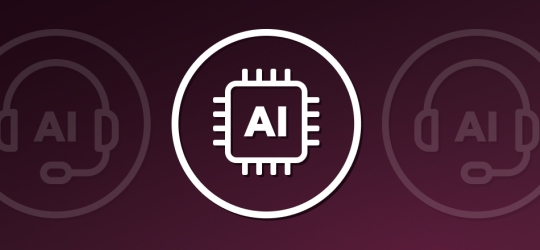What’s Next: The Evolution of AI in Contact Centers .
The State of AI in Contact Centers: Part 2
Read Part 1: The Current Landscape: AI Adoption and Capabilities in Contact Centers

Generative AI: The Next Frontier
The next wave of AI innovation is poised to make contact center interactions even more seamless and intelligent. One of the biggest trends is the rise of generative AI – AI that can create content and engage in free-form conversations. Large language models (LLMs) like GPT-4 are being explored to power more advanced chatbots that can handle nuanced queries and produce human-like responses. Imagine a customer emailing support and getting a coherent, detailed answer composed by an AI that has analyzed their issue and pulled information from various knowledge bases. Or an AI chat agent that can carry on a multi-turn conversation, ask clarifying questions, and troubleshoot complex problems – far beyond the capabilities of today's scripted bots.
Current Applications
We're already seeing early uses of generative AI in contact centers, such as automated call summarization (AI that listens to a call and instantly generates an accurate summary and action items for the agent) and draft email responses that agents can review and send. 68% of service professionals believe generative AI improves customer self-service by delivering quicker resolutions to questions (AI Customer Service Trends to Watch in 2025 | Retell AI). In the near future, AI could handle more of the heavy lifting in interactions, while humans supervise and intervene when needed.
Emotional Intelligence and Sentiment Analysis
Another area of advancement is emotional AI and sentiment analysis. Future AI systems aim to not just recognize what a customer is saying, but how they're feeling. This means better real-time detection of frustration or confusion (through voice tone, word choice, or even silences), prompting either a change in the bot's approach or an immediate flag for human takeover. We can expect AI to become more adept at knowing its own limits – for example, an AI chat might gracefully hand off to a human agent when it detects the customer is unhappy or the query is too complex, rather than spinning in circles. This kind of dynamic orchestration between AI and humans will greatly improve customer experiences.
Technical Infrastructure
On the technical side, continued migration of contact centers to cloud platforms and the integration of customer data will fuel AI's growth. Cloud contact center solutions increasingly come with AI features built-in – from speech recognition to machine learning analytics – making it easier for organizations to plug-and-play AI capabilities. As more customer interaction data (calls, chats, social messages) is aggregated in one place, AI models can be trained on a 360-degree view of the customer. This will enable hyper-personalization, where AI can tailor responses not just to the immediate question but to the customer's history and preferences. For instance, an AI system might proactively offer a solution based on a problem it predicts the customer is likely to face next, or adjust its tone and vocabulary to match the customer's profile.
Market Growth and Investment
The market forecasts reflect this optimistic trajectory. Analysts project the global call center AI market will grow tremendously in the coming years – with one report estimating an increase from $1.7 billion in 2022 to about $6 billion by 2032. That's an annual growth rate of roughly 19-20% (CAGR) through 2032 ( Building Ethical AI Practices ), outpacing many other technology investments. This growth is driven by tangible benefits companies are seeing (like cost savings and higher customer satisfaction) and by competitive pressure – nobody wants to be left behind if their rivals are delighting customers with AI-driven service.
Challenges and Considerations
However, along with excitement about AI's potential, industry leaders are keeping a pragmatic eye on challenges that could arise. Operational complexity is one: implementing advanced AI often means integrating with multiple systems (CRM databases, telephony, mobile apps) and retraining staff to work with new tools. There's also the question of diminishing returns – once your chatbot handles, say, 50% of simple queries, pushing that to 80% might be much harder, as the remaining queries are inherently more complex or require a human touch. Businesses will need to carefully choose which additional tasks to automate next for the best ROI. Customer acceptance is another factor. While studies show customers are increasingly open to AI help, patience wears thin if the AI fails to resolve their problem. Ensuring a smooth fallback to human support is crucial (more on that in the next section).
The Evolving Workforce
There's also the broader workforce consideration: as AI takes on more tasks, the role of human agents will evolve. Rather than handling repetitive calls, tomorrow's agents may act more as concierges or specialists, stepping in when higher-level intervention is needed. They'll need deeper training in soft skills and complex problem-solving, supported by AI tools feeding them information. Many companies are already investing in upskilling their teams so agents can work hand-in-hand with AI. As Tactis has written about the past, "implementing AI in your business is not just about technology—it's about transforming your organization to thrive in a changing world", and "the goal isn't to replace human talent but to enhance their output and keep your company connected on a human level" (Implementing AI Tools: Transforming Your Business for the Future | Tactis). Our perspective is: AI will handle more volume, but humans will handle more value.
Looking Ahead
In summary, the future of AI in contact centers is incredibly promising. We're looking at faster, smarter customer service that can feel instantaneous and personalized. Yet even as AI does more of the talking and typing, human agents and managers will play a critical role in guiding the technology, stepping in at pivotal moments, and ensuring that customer care remains, at its core, a human-centered endeavor.